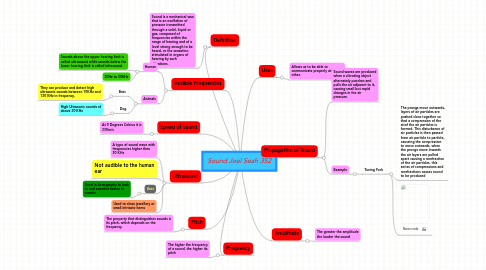
1. Ultrasound
1.1. A type of sound wave with frequencies higher than 20 KHz
1.2. Not audible to the human ear
1.3. Uses
1.3.1. Used in Sonography to look at and examine foetus in wombs
1.4. Used to clean jewellery or small intricate items
2. Definition
2.1. Sound is a mechanical wae that is an oscillation of pressure transmitted through a solid, liquid or gas, composed of frequencies within the range of hearing and of a level strong enough to be heard, or the sensation stimulated in organs of hearing by such vibrations.
3. Audible Frequencies
3.1. Human
3.1.1. Sounds above the upper hearing limit is called ultrasound while sounds below the lower hearing limit is called infrasound.
3.1.2. 20Hz to 20KHz
3.2. Animals
3.2.1. Bats
3.2.1.1. They can produce and detect high ultrasonic sounds between 10KHz and 120 KHz in frequency.
3.2.2. Dog
3.2.2.1. High Ultrasonic sounds of above 20 KHz
4. Speed of Sound
4.1. At 0 Degrees Celsius it is 330m/s
5. Pitch
5.1. The property that distinguishes sounds is its pitch, which depends on the frequency.
6. Frequency
6.1. The higher the frequency of a sound, the higher its pitch
7. Uses
7.1. Allows us to be able to communicate properly with each other.
8. Propagation of Sound
8.1. Sound waves are produced when a vibrating object alternately punches and pulls the air adjacent to it, causing small but rapid changes in the air pressure.
8.2. Example
8.2.1. Tuning Fork
8.2.1.1. The prongs move outwards, layers of air particles are pushed close together so that a compression of the airof the air particles is formed. This disturbance of air particles is then passed from air particle to particle, causeing the compression to move outwards. when the prongs move inwards the air layers are pulled apart causing a rarefraction of the air particles. this series of compressions and rarefractions causes sound to be produced
8.2.1.2. New node
